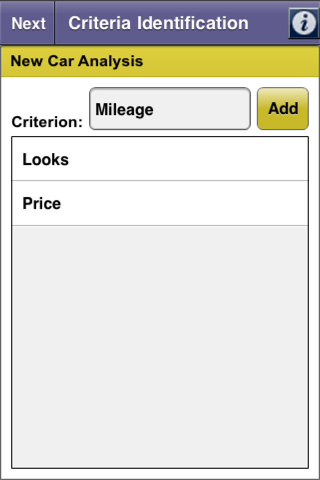
Have you ever had difficulty comparing two or more options, such as potential new cars, and felt like you were comparing apples to oranges? You liked one car because of it’s warrantee and maintenance support, another because of its styling, another because of its price and fuel economy… each car was a “better” choice in some way, but no one car was a clear winner?
Weighted Ranking is a structured analytic app for consistently comparing different options (like new cars) and rigorously applying the same criteria to each option. It is the perfect tool for evaluating a set of options (including cars, homes, job candidates, job offers, vacation destinations, and on and on) against a set of competing criteria (like price, style, location, experience level, pay).
First, you enter all of the potential criteria that you have for selecting an option. For example, let’s say you’re purchasing a new car. Your criteria might include purchase price, styling, comfort, and handling. The app facilitates ranking the criteria, by asking you to compare each pair of criteria to see which criterion is more important to your analysis. It will ask you to pick either “purchase price” or “styling,” then to pick either “purchase price” or “comfort,” etc., until you’ve pair-ranked all of the criteria.
Based on your answers, the app then assigns a relative weighting factor, or simply a weight, to each criterion. The weight is a multiplier between 0 and 1 that reflects the relative importance of the associated criterion. You can modify the app’s calculated weights if you want to. The weighted criteria set an overall standard for how the options will be ranked.
Next you enter the options, which in the case of a new car purchase would be the cars that have made it to your final cut, perhaps half a dozen or fewer different models.
For each criterion, the app will ask you to evaluate all of the options using the pair-ranking technique. So if your list of cars included a Chevy, Toyota, Ford, and Honda, the app would ask you to pick the Chevy model you’ve entered or the Toyota model, according to “purchase price.” You would pick the “better” model, or the one with the lower price (assuming your criterion “purchase price” meant that lower was better!), then the app would continue the questioning until you’ve compared each option with each other option according to “purchase price.”
The app would repeat the questioning, leading you through a thorough, step-by-step comparison of every option against every other option according to each criterion. The total number of comparisons you’ll be asked to do depends on the number of options and the number of criteria.
When finished, the app will score all of the options, using the weighted criteria, and display a ranking of the options. The app saves the analysis in case you need to go back and delete an option or re-rank anything.



